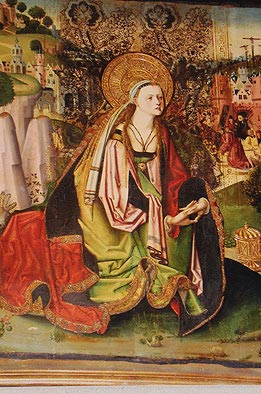BRINGING HERITAGE CLOSER. TUDELA
2 September 2008
Artistic relations between Aragon and Navarre in the 15th century: the case of the cathedral of Tudela
Carmen Lacarra Ducay. University of Zaragoza
Throughout the 15th century, the Collegiate Church of Santa Maria la Blanca in Tudela enriched its movable heritage with important works of sculpture and painting, some of which are still preserved today.
From its historical and artistic analysis we can deduce the close relationship between the workshops of sculptors and painters working in Tudela, Tarazona and Saragossa in the same century.
The political history of the Kingdom of Navarre, united with that of the Kingdom of Aragon for some time, contributed to this, as did the patronage work carried out by the high clergy and the nobility, motivated by similar interests of exalting their own report. In fact, it was the members of the royalty and the representatives of the Church who played the role of patrons, contributing effectively to the dissemination and rooting of the same artistic models in large areas of Navarre and Aragon.
The chapter of Tudela Cathedral, presided over by a mitred dean, depended on the see of Tarazona (Zaragoza), status which would remain in force until March 1783, when Pope Pius VI created the bishopric of Tudela for the first time.
If the words of Father Florentino Zamora are true in religious terms, "It is not possible to write the ecclesiastical history of Tudela without referring to Tarazona due to its affinity of churches and their interdependence over the centuries", the same is true in the field of the Fine Arts, with simultaneous performances by sculptors and painters worthy representatives of the latest trends in Gothic art.
A study of the works of imagery and panel painting that have survived to the present day offers a broad overview of the various trends in the Gothic style of the Fourteenth century, from the International to the Hispano-Flemish and Germanic.
One example of panel painting is the altarpiece of Our Lady of Hope between Saint Francis of Assisi and Saint Giles Abbot, a work executed in 1412 by the Zaragozan painter Bonanat Zahortiga for the funerary chapel of the chancellor Francés de Villaespesa, located at the head of the cathedral on the epistle side. The Aragonese origin of the commissioner and the popularity achieved by the painter with this altarpiece are justified by other works by Zahortiga for Zaragoza cathedral.
And as a late example, within the 15th century, we find the grandiose altarpiece that serves as a wonderful backdrop to the Romanesque main chapel, which we have described as "the most important bequest of the northern Gothic style preserved in Navarre". The success achieved by this work, carried out between 1486 and 1495 by the painters Pedro de Oviedo and Diego del Águila, led to the first of the two painters, possibly head of the workshop, being commissioned to paint new altarpieces for different towns in the diocese of Tarazona.

Altarpiece of Santa Catalina (detail). Tudela Cathedral

High altarpiece (detail). Tudela Cathedral

High altarpiece (detail). Tudela Cathedral
PROGRAM
TUESDAY, 2 SEPTEMBER
Place: Tudela. Dean's Palace
16.30 h: Opening and presentation of the course
16.45 h. The recovery of the ornamentation of Tudela Cathedral
Ms. Mercedes Jover Hernando. Chair of Navarrese Heritage and Art
17.45 h. Coffee break
18.15 h. Santa María de Tudela and the medieval architecture of the Ebro Valley
Mr. Javier Martinez de Aguirre Aldaz. Complutense University of Madrid
19.15 h. Artistic relations between Aragon and Navarre in the 15th century: the case of Tudela Cathedral
Ms. Carmen Lacarra Ducay. University of Zaragoza
20.15 h. visit guided tour of the cloister of Tudela Cathedral
WEDNESDAY, 3 SEPTEMBER
Place: Tudela. Dean's Palace
16.30 h. Architecture and the city in the 16th century
Ms. María Josefa Tarifa Castilla. Chair of Navarrese Heritage and Art
17.30 h. Coffee break
18.00 h. Illustrious women of the Renaissance in the Magallón palace
Ms. Mª Concepción García Gainza. Chair of Navarrese Heritage and Art
19.00 h. visit to the Magallón palace
THURSDAY, 4 SEPTEMBER
Place: Tudela. Dean's Palace
16.30 h. Art and devotions in Tudela between the 16th and 18th centuries
D. Ricardo Fernández Gracia. Chair of Navarrese Heritage and Art
17.30 h. Coffee break
18.00 h. visit guided tour of the convents of the Company of Mary, Capuchin and Dominican nuns in Tudela
FRIDAY, 5 SEPTEMBER
Place: Tudela. Dean's Palace
16.30 h. Art, report and collective identity: The commemorative monument in the city of Tudela
Mr. José Javier Azanza López. Chair of Navarrese Heritage and Art
17.30 h. Coffee break
18.00 h. Tudela and Navarrese painting from the period between the centuries
D. Ignacio J. Urricelqui. Chair of Navarrese Heritage and Art
19.00 h. The Bardenas and La Mejana. Landscape and still life in Tudela painting
D. Manuel Motilva Albericio. Director of the Muñoz Sola Museum in Tudela.
20.00 h. Closing ceremony
